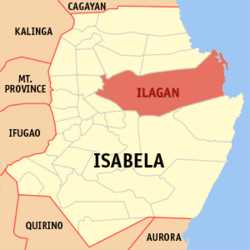Ilagan
| Ilagan | ||
|---|---|---|
| Component City | ||
| City of Ilagan | ||
 |
||
|
||
| Nickname(s): The Center of Eco-Tourism Adventure in Region 2 Home of the World's Largest Wooden Lounge Chair (Butaka) Corn Capital of the Philippines Primary Growth Center of Region 2 Isabela Provincial Capital |
||
| Motto: Sulong Pa! City of Ilagan (More Progress! City of Ilagan) |
||
 Location in the province of Isabela |
||
| Location within the Philippines | ||
| Coordinates: 17°08′N 121°53′E / 17.13°N 121.88°ECoordinates: 17°08′N 121°53′E / 17.13°N 121.88°E | ||
| Country | Philippines | |
| Region | Cagayan Valley (Region II) | |
| Province | Isabela | |
| District | 1st District of Isabela | |
| Incorporated | 4 May 1686 | |
| Cityhood | 11 August 2012 | |
| Barangays | 91 | |
| Government | ||
| • Mayor | Evelyn C. Diaz | |
| • Vice Mayor | Vedasto D. Villanueva | |
| • Electorate | 88,413 voters (2016 election) | |
| Area | ||
| • Total | 1,166.26 km2 (450.30 sq mi) | |
| Elevation | 110 m (360 ft) | |
| Population (2015 census) | ||
| • Total | 145,568 | |
| • Density | 120/km2 (320/sq mi) | |
| Demonym(s) | Ilagueño (m) Ilagueña (f) |
|
| Time zone | PST (UTC+8) | |
| ZIP code | 3300 | |
| 023114000 | ||
| Dialing code | +63 (0)78 | |
| Income class | 2nd city income class | |
| Revenue | ₱ 185,000,000.00 (2016) | |
| Poverty incidence | 17.86 (2012) | |
| Website | www |
|
Ilagan, officially the City of Ilagan (Ibanag: Siudad nat Ilagan; Ilocano: Ciudad ti Ilagan; Filipino: Lungsod ng Ilagan) (PSGC: 023114000), is a 2nd class city and the provincial capital of the province of Isabela, Philippines. It is the most populous city in the province with a population of 145,568 according to 2015 census. With a total land area of 116,626 hectares (288,190 acres), it is the largest city in the island of Luzon and the fourth largest city (in terms of land area) in the Philippines, after Davao City, Puerto Princesa and Zamboanga City. It holds the title as the most number of voters in the province with 88,413 voters.
Ilagan was a first class municipality before becoming a city.
The town was then called by its native Gaddang settlers as Bolo during the pre-Spanish conquest era. It is one of the populous settlement during that period and site of the vast tobacco plantation in the region making it one of the most important economic areas in northern Luzon. Shortly after Juan de Salcedo conquered Northern Luzon in 1587, Gov. Rodrigo de Penalosa sent Capt. Pablo de Carreon to explore Cagayan Valley as well as to establish missions in towns. Among the Spanish missionaries who penetrated deeply into the region was P. Pedro Jimenez, who founded Ilagan.
The town of Bolo was founded by the Dominicans in 1619 in honor of Saint Ferdinand of Castile. The old Bolo was situated in the western side of Cagayan River in what is known today as Barangay Naguilian-Baculod. The cultural shock brought by the dominating social and economic regulations introduced by the Spanish authorities propelled the natives to dissent in the Mallig and Ilagan-Tumauini territories in what was known as the Gaddang Revolution. The natives abandoned their settlement after burning their church and houses until 1622 when the Spanish government pardoned and exempted them from paying tribute within three years. After the Gaddang revolt, the natives re-established their settlement upon the efforts of Fr. Pedro Jimenez in 1678 on the east side of the river thereby giving the legendary name for Ilagan which is the reverse of the word Nagali meaning "transfer". The Dominicans accepted the settlement as an ecclesiastical mission given the name San Fernando de Ilagan in honor of its patron, Saint Ferdinand of Castile.
...
Wikipedia


